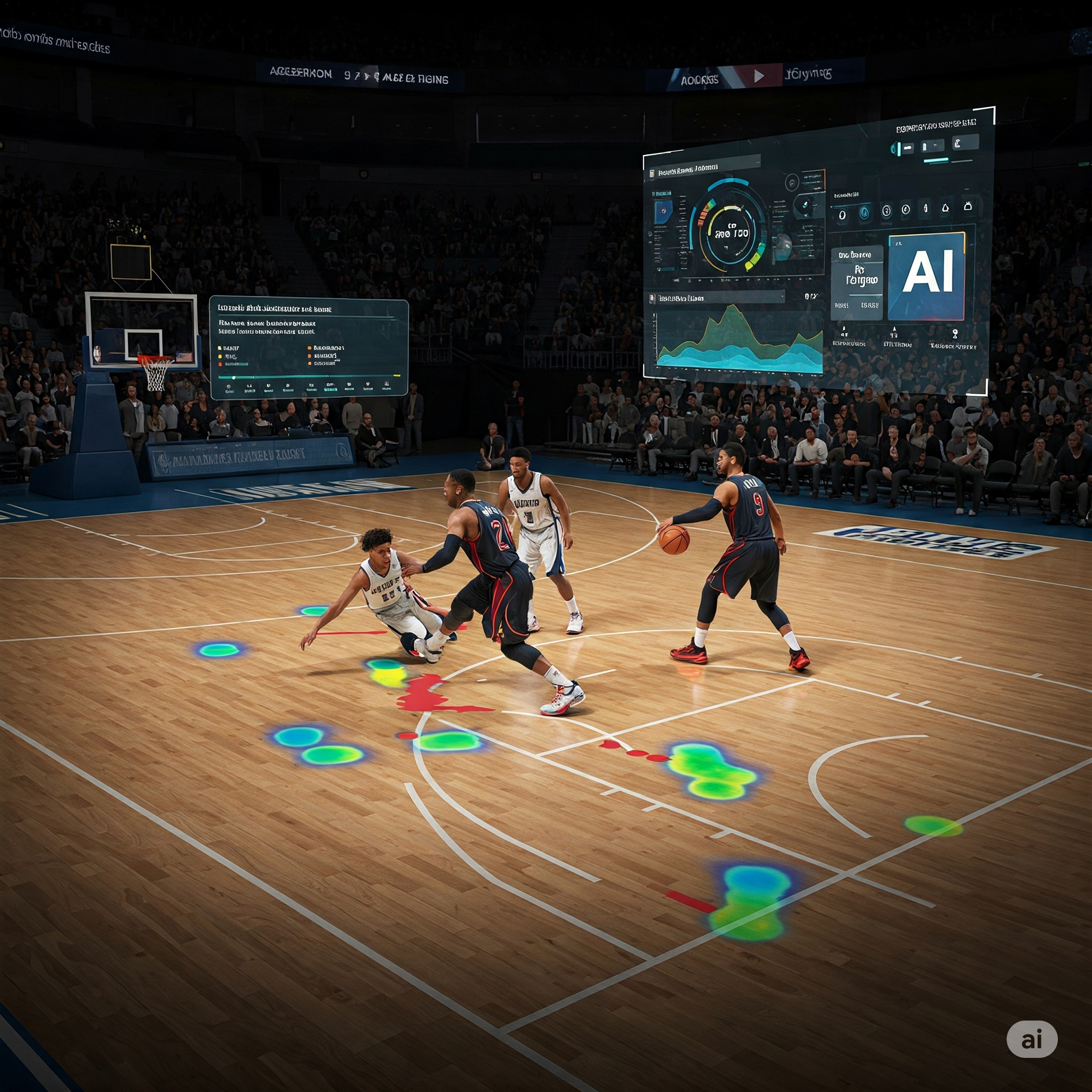Sports analytics, the practice of examining sports-related data to uncover patterns and insights, has become an indispensable tool for teams, coaches, and athletes seeking a competitive edge. Now, Artificial Intelligence (AI) is revolutionizing this domain, moving beyond basic statistics to provide deeper, more predictive, and actionable intelligence. By leveraging the power of machine learning, computer vision, and data mining, AI is transforming how athletic performance is analyzed, injuries are prevented, game strategies are formulated, and even how fans engage with their favorite sports.
The modern sports landscape generates an unprecedented amount of data. Wearable devices track a multitude of biometric signals, sensors embedded in equipment capture intricate movement patterns, and video analysis provides a visual record of every play. AI serves as the engine that can process this massive influx of information, turning raw data points into meaningful insights that drive better decision-making on and off the field.
What is AI in Sports Analytics?
AI in sports analytics involves the application of advanced computational techniques to interpret and extract valuable information from athletic data. This encompasses several key areas:
- Machine Learning (ML): Algorithms that learn from data without explicit programming, enabling AI to identify patterns in player performance, predict outcomes, and personalize training regimens.
- Computer Vision: AI systems that can “see” and interpret visual data from video footage, tracking player movements, ball trajectories, and even identifying tactical formations in real-time.
- Data Mining: Techniques used to discover hidden patterns and correlations within large datasets, revealing insights that might not be apparent through traditional statistical methods.
The foundation of AI in sports analytics is big data. Massive datasets encompassing performance metrics (speed, agility, strength), biometric data (heart rate, sleep patterns, fatigue levels), and gameplay data (passes, shots, tackles) are collected and processed by AI algorithms. This allows for a far more granular and dynamic understanding of athletic performance than ever before.
Key Applications of AI in Sports
AI is being applied across a wide spectrum of sports, impacting various aspects of the game:
a) Performance Optimization:
- Wearable devices continuously monitor athletes’ physiological data, including heart rate variability, acceleration, deceleration, sleep quality, and muscle load.
- AI models analyze this data to predict optimal performance windows, identify signs of fatigue, and recommend adjustments to training loads to maximize athletic potential.
- Personalized training programs are developed using ML algorithms that take into account individual athlete biometrics, performance history, and recovery patterns, leading to more effective and tailored training.
b) Injury Prevention and Recovery:
- Predictive analytics utilize historical injury data, training loads, and biometric information to identify early indicators of overtraining or increased risk of injury.
- AI analyzes motion patterns and biomechanics captured through sensors and video analysis to detect subtle anomalies in movement that could predispose an athlete to injury.
- Example: The Zone7 system is used by elite sports teams to analyze athlete data and provide insights that help prevent soft-tissue injuries by identifying athletes at high risk based on their training and recovery patterns.
c) Game Strategy and Tactics:
- AI reviews vast amounts of historical game footage to identify successful plays, effective formations, and optimal tactical approaches for specific opponents and game situations.
- Opponent analysis is enhanced by AI, which can identify an opponent’s strengths, weaknesses, common tendencies, and predictable patterns of play.
- This is being implemented in sports like American football (predicting play calls), soccer (optimizing team formations and player positioning), cricket (analyzing batsman tendencies and field placements), and basketball (identifying defensive vulnerabilities).
d) Scouting and Talent Identification:
- AI processes massive datasets on young and amateur players, including performance statistics, scouting reports, and biometric measurements.
- This helps identify potentially underrated talent that might be missed by traditional scouting methods, echoing the “Moneyball 2.0” concept of data-driven player evaluation.
e) Refereeing and Decision-Making:
- Computer vision systems like Hawk-Eye in tennis and cricket, and VAR (Video Assistant Referee) in football, assist referees in making accurate real-time decisions on close calls.
- AI analyzes video footage to determine ball placement, player positioning, and potential rule violations, leading to less human error and greater transparency in officiating.
f) Fan Experience and Engagement:
- AI chatbots provide fans with instant answers to questions about teams, players, and game statistics, enhancing interaction and accessibility.
- Personalized content delivery is driven by AI algorithms that analyze fan preferences to deliver tailored match highlights, player statistics, and news feeds.
- Virtual and Augmented Reality (VR/AR) experiences are being enhanced by AI to create more immersive and interactive fan engagements, such as virtual stadium tours and real-time augmented reality overlays during live broadcasts.
g) Betting and Fantasy Sports:
- AI models analyze vast amounts of historical data and real-time information to generate predictions for match outcomes and individual player performances, informing betting strategies.
- Fantasy sports platforms utilize AI to provide smarter player recommendations and projections for users building their virtual teams.
Real-World Use Cases
The impact of AI in sports analytics is evident in its adoption by leading teams and organizations worldwide:
- FC Barcelona & Real Madrid: These top football clubs utilize AI-based tracking systems and advanced analytics to gain insights into player performance, optimize training routines, and analyze tactical approaches for upcoming matches.
- NBA: The NBA employs Second Spectrum AI cameras that track the movement of every player and the ball in real-time, generating a wealth of data on spacing, passing lanes, and defensive coverage used for both team analysis and fan engagement.
- IBM Watson & Wimbledon: IBM Watson provides AI-powered highlight reels, player statistics, and insightful commentary during the Wimbledon tennis championships, enhancing the viewing experience for fans.
- NFL: The National Football League (NFL) leverages AWS AI systems to provide real-time statistics, predict player injuries based on biomechanical analysis, and offer deeper insights into gameplay.
- Cricket: AI is used to analyze ball trajectory, predict outcomes based on various match conditions, and even generate predictive commentary during live broadcasts.
- Formula 1: The McLaren Formula 1 team utilizes AI for complex race simulations, optimizing car setups, and making real-time strategic decisions during races based on vast amounts of sensor data.
Benefits of AI in Sports
The integration of AI into sports analytics yields significant advantages:
- Data-driven decisions: AI empowers coaches and managers to make strategic decisions based on objective data and predictive insights rather than relying solely on intuition.
- Reduced injuries and increased player longevity: By identifying injury risks early, AI can help implement preventative measures, leading to fewer injuries and extending players’ careers.
- Boosted team coordination: Precise analytics on player movement and positioning can enhance team coordination and tactical execution.
- Enhanced fan experience: AI-powered content personalization and immersive technologies create more engaging and interactive experiences for sports fans.
- Fairer play and accurate officiating: AI-assisted refereeing minimizes human error and increases the accuracy and transparency of crucial game decisions.
Challenges and Concerns
Despite its benefits, the use of AI in sports analytics also presents several challenges and concerns:
- Data privacy of athletes: The collection and analysis of detailed biometric and performance data raise concerns about the privacy and security of athletes’ personal information.
- Over-reliance on AI over human intuition: There’s a risk of coaches and managers becoming overly reliant on AI-generated insights, potentially diminishing the importance of human intuition and experience.
- Bias in AI predictions: The accuracy and fairness of AI predictions are heavily dependent on the quality and representativeness of the training data. Biases in the data can lead to skewed or unfair outcomes.
- High cost of AI implementation: Implementing sophisticated AI systems and infrastructure can be expensive, potentially creating a technological divide between large, wealthy organizations and smaller leagues or teams.
- Ethical concerns in using personal biometric data for commercial gain: Questions arise regarding the ethical implications of using athletes’ sensitive biometric data for commercial purposes, such as marketing or betting.
The Future of AI in Sports
The future of AI in sports promises even more sophisticated applications:
- Predictive simulations for entire seasons: AI models could simulate entire seasons based on various factors, providing insights into potential outcomes and strategic planning.
- AI coaches and virtual assistants for players: Personalized AI coaches could provide athletes with real-time feedback, training recommendations, and performance analysis.
- Real-time health monitoring and diagnosis during live games: Advanced wearable AI could potentially monitor athletes’ health in real-time and even provide early diagnosis of injuries during live games.
- Expansion into amateur and youth sports: As AI technology becomes more accessible and affordable, its use is likely to expand into amateur and youth sports, providing valuable insights at all levels of competition.
Quote: As an insightful observation on the evolving landscape of sports technology suggests, “The next revolution in sports won’t come from the field—it will come from the cloud.” This underscores the transformative power of data and AI in shaping the future of athletic competition.
Conclusion
Artificial Intelligence is not merely augmenting sports analytics; it is fundamentally changing the way sports are played, watched, and managed. By providing data-driven insights that enhance athlete performance, prevent injuries, optimize strategies, and engage fans, AI is unlocking new levels of understanding and competitive advantage. While challenges and ethical considerations must be carefully addressed, the future of sports is inextricably linked with the continued evolution and integration of artificial intelligence, promising an exciting era for athletes, fans, and analysts alike.





